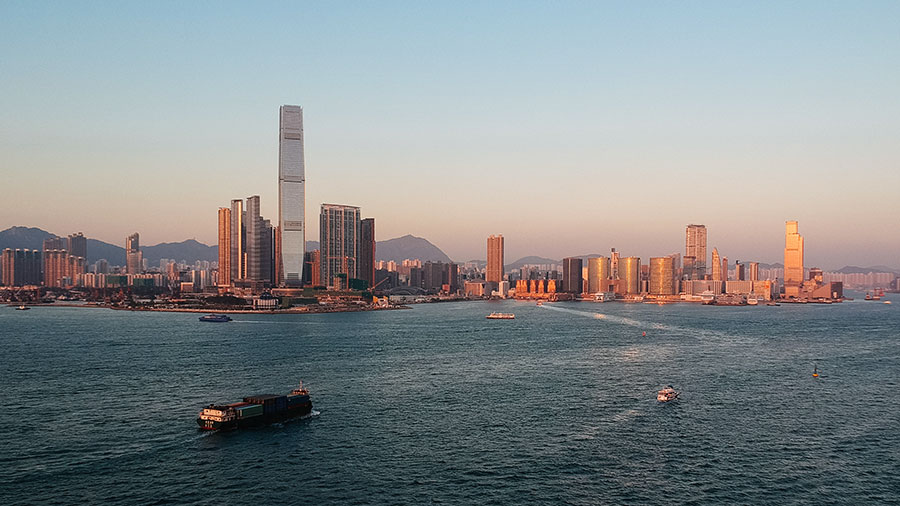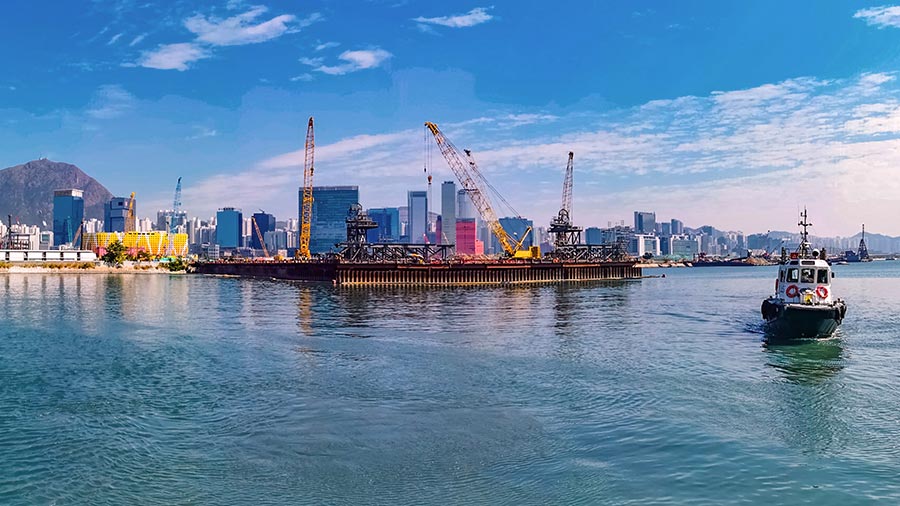Economic Indicators and Hong Kong's GDP, FDI, and Trade Trends
Hong Kong Gross Domestic Product Growth and 2025-2026 Forecast
The Hong Kong economy expanded solidly in the first quarter of 2025, demonstrating significant improvement over previous periods. According to advance estimates, real GDP grew by 3.1 percent year-on-year, accelerating from the 2.5 percent growth recorded in the preceding quarter. This marks the strongest growth since the fourth quarter of 2023, primarily driven by robust external demand. On a seasonally adjusted quarter-to-quarter basis, real GDP grew notably by 2.0 percent, the most pronounced increase in two years.
The first quarter growth was primarily fueled by a significant surge in exports. Goods exports increased by 8.7 percent (compared to 1.3% in Q4 2024), while services exports edged higher to 6.6 percent (from 6.5%). Additionally, gross domestic fixed capital formation recovered with a 2.8 percent growth, reversing the previous quarter's decline of 0.7 percent.
Looking ahead, Hong Kong's GDP is projected to grow by 2.3 percent in 2025, slightly below 2024's 2.5 percent, before rising again to 2.5 percent in 2026. This modest forecast reflects the impact of escalating trade tensions between the United States and China, which directly affects Hong Kong due to its position as a regional trade hub.
Foreign Direct Investment trends
Hong Kong achieved unprecedented foreign direct investment results in 2024, reinforcing its status as a premier global business hub. Invest Hong Kong (InvestHK) reported assisting 539 overseas and Mainland companies in establishing or expanding operations in the city, representing a substantial 41 percent increase compared to 2023. These investments are estimated to have contributed over HK$67.7 billion to Hong Kong's economy-a record high and nearly 10 percent increase from 2023-with projections to create 6,864 job opportunities during the first year of operation, marking a 67 percent rise from the previous year.
The primary sources of these investments were the Chinese Mainland (273 companies), followed by the United States (52), France (24), the United Kingdom (24), and Singapore (23). The top sectors attracting investment included innovation and technology (120), financial services and fintech (110), family offices (95), tourism and hospitality (58), and business and professional services (47).
According to the World Investment Report 2024 released by UNCTAD, Hong Kong received USD 112.6 billion in FDI inflows in 2023, a 2.7 percent increase from USD 109.6 billion in 2022, positioning Hong Kong as the fourth-largest FDI recipient globally. By the end of 2023, Hong Kong's total FDI stock stood at an impressive USD 2.1 trillion.
The primary countries contributing to Hong Kong's FDI stock were China (31.1%), the British Virgin Islands (30.5%), the Cayman Islands (10.6%), and the United Kingdom (9.3%). In terms of sectoral distribution, investment and holding, real estate, and professional and business services accounted for the largest share at 67.1 percent of Hong Kong's inward direct investment, followed by banking at 11.6 percent, and import/export, wholesale, and retail trades at 10.8 percent.
Additionally, the New Capital Investment Entrant Scheme (New CIES), launched in March 2024, had received over 800 applications by the end of 2024, with enhancements in effect in March 2025 expected to attract even more investment.
Hong Kong trade trends
Hong Kong's merchandise exports demonstrated strong growth in early 2025, with a sharp 18.5 percent increase in March compared to the previous year. Exports to the Chinese Mainland grew significantly, while those to the United States also showed visible improvement, and those to the European Union registered a marginal increase. This builds on the momentum from 2024, when Hong Kong's exports grew by 9.9 percent in the first ten months of the year.
However, the global trade landscape changed dramatically in April 2025, when the United States imposed significant tariff increases, escalating trade tensions worldwide. The US implemented 10 percent additional tariffs on Chinese goods on February 10, which were further raised to 20 percent on March 4, 2025. These developments are expected to dampen trade with the Chinese Mainland, which accounts for approximately half of Hong Kong's trade activity.
Despite these challenges, the steady growth of the Mainland economy, combined with Hong Kong's proactive efforts to enhance economic and trade relationships with different markets, is expected to provide some cushioning for its trade performance. The government continues to provide support to enterprises and citizens in navigating this complex trade environment.
| Hong Kong Economic Profile (1990-2020) | ||||
| 1990 | 2000 | 2010 | 2020 | |
| World view | ||||
| Population, total (millions) | 5.7 | 6.67 | 7.02 | 7.48 |
| Population growth (annual %) | 0.3 | 0.9 | 0.7 | -0.3 |
| Surface area (sq. km) (thousands) | 1.1 | 1.1 | 1.1 | 1.1 |
| Population density (people per sq. km of land area) | 5,762.10 | 6,347.60 | 6,689.70 | 7,125.50 |
| Poverty headcount ratio at national poverty lines (% of population) | .. | .. | .. | .. |
| Poverty headcount ratio at $1.90 a day (2011 PPP) (% of population) | .. | .. | .. | .. |
| GNI, Atlas method (current US$) (billions) | 72.22 | 179.5 | 236.17 | 363.85 |
| GNI per capita, Atlas method (current US$) | 12,660 | 26,930 | 33,620 | 48,630 |
| GNI, PPP (current international $) (billions) | 101.32 | 189.82 | 352.8 | 494 |
| GNI per capita, PPP (current international $) | 17,760 | 28,480 | 50,230 | 65,800 |
| People | ||||
| Income share held by lowest 20% | .. | .. | .. | .. |
| Life expectancy at birth, total (years) | 77 | 81 | 83 | 85 |
| Fertility rate, total (births per woman) | 1.3 | 1 | 1.1 | 1.1 |
| Adolescent fertility rate (births per 1,000 women ages 15-19) | 7 | 4 | 3 | 3 |
| Contraceptive prevalence, any methods (% of women ages 15-49) | 86 | 86 | 75 | 67 |
| Births attended by skilled health staff (% of total) | .. | .. | .. | .. |
| Mortality rate, under-5 (per 1,000 live births) | .. | .. | .. | .. |
| Prevalence of underweight, weight for age (% of children under 5) | .. | .. | .. | .. |
| Immunization, measles (% of children ages 12-23 months) | .. | .. | .. | .. |
| Primary completion rate, total (% of relevant age group) | 104 | .. | 101 | 105 |
| School enrollment, primary (% gross) | 108.9 | 97.9 | 103.9 | 107.8 |
| School enrollment, secondary (% gross) | 75 | 80 | 88 | 108 |
| School enrollment, primary and secondary (gross), gender parity index (GPI) | 1 | .. | 1 | 1 |
| Prevalence of HIV, total (% of population ages 15-49) | .. | .. | .. | .. |
| Environment | ||||
| Forest area (sq. km) (thousands) | .. | .. | .. | .. |
| Terrestrial and marine protected areas (% of total territorial area) | .. | .. | .. | 48.9 |
| Annual freshwater withdrawals, total (% of internal resources) | .. | .. | .. | .. |
| Urban population growth (annual %) | 0.7 | 0.9 | 0.7 | -0.3 |
| Energy use (kg of oil equivalent per capita) | 1,511 | 2,039 | 1,947 | .. |
| CO2 emissions (metric tons per capita) | 5.34 | .. | .. | .. |
| Electric power consumption (kWh per capita) | 4,178 | 5,447 | 5,973 | .. |
| Economy | ||||
| GDP (current US$) (billions) | 76.93 | 171.67 | 228.64 | 346.59 |
| GDP growth (annual %) | 3.8 | 7.7 | 6.8 | -6.1 |
| Inflation, GDP deflator (annual %) | 7.6 | -3.4 | 0.3 | 0.6 |
| Agriculture, forestry, and fishing, value added (% of GDP) | .. | 0 | 0 | 0 |
| Industry (including construction), value added (% of GDP) | .. | 12 | 7 | 6 |
| Exports of goods and services (% of GDP) | 117 | 126 | 205 | 177 |
| Imports of goods and services (% of GDP) | 109 | 122 | 199 | 175 |
| Gross capital formation (% of GDP) | 27 | 28 | 24 | 19 |
| Revenue, excluding grants (% of GDP) | .. | .. | .. | .. |
| Net lending (+) / net borrowing (-) (% of GDP) | .. | .. | .. | .. |
| States and markets | ||||
| Time required to start a business (days) | .. | 11 | 6 | 2 |
| Domestic credit provided by financial sector (% of GDP) | .. | .. | .. | .. |
| Tax revenue (% of GDP) | .. | .. | .. | .. |
| Military expenditure (% of GDP) | .. | .. | .. | .. |
| Mobile cellular subscriptions (per 100 people) | 2.3 | 82.5 | 198 | 291.7 |
| Individuals using the Internet (% of population) | 0 | 27.8 | 72 | 92.4 |
| High-technology exports (% of manufactured exports) | .. | .. | 37 | 70 |
| Statistical Capacity Score (Overall Average) (scale 0 - 100) | .. | .. | .. | .. |
| Global links | ||||
| Merchandise trade (% of GDP) | 217 | 243 | 368 | 323 |
| Net barter terms of trade index (2000 = 100) | 100 | 100 | 97 | 97 |
| External debt stocks, total (DOD, current US$) (millions) | .. | .. | .. | .. |
| Total debt service (% of exports of goods, services and primary income) | .. | .. | .. | .. |
| Net migration (thousands) | 156 | 65 | 75 | 147 |
| Personal remittances, received (current US$) (millions) | .. | 136 | 340 | 458 |
| Foreign direct investment, net inflows (BoP, current US$) (millions) | 3,275 | 70,496 | 82,709 | 58,299 |
| Net official development assistance received (current US$) (millions) | 38.2 | .. | .. | .. |








